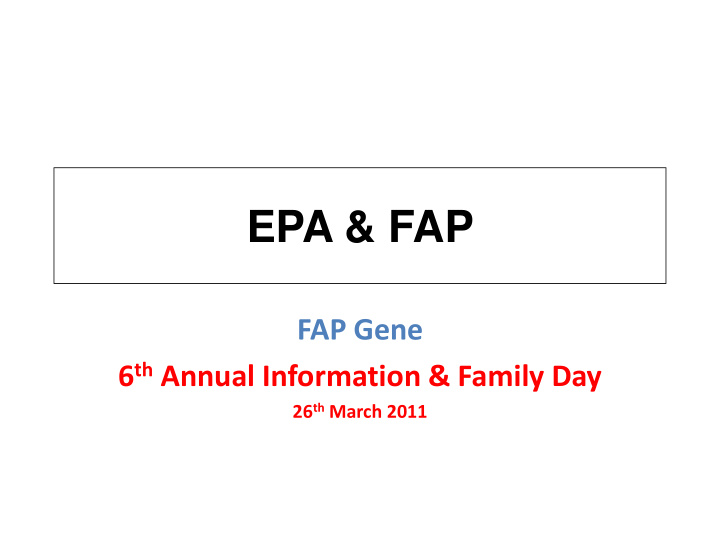



EPA & FAP FAP Gene 6 th Annual Information & Family Day 26 th March 2011
What is EPA? • Eicosapentaenoic acid (EPA) is an omega-3 fatty acid • A normal component of cells in the body • Essential fatty acid (need to have it in the diet) • Evidence for variety of benefits on cardiovascular health • Communities with high intake of omega-3 fatty acids tend to have lower incidence of bowel cancer
Sources of Omega-3 PUFAs Herring Sardine Salmon
Why do we think EPA might have benefits in FAP?
How do polyps form?
Development of polyps
Controlling development of polyps • Chance of developing cancer depends on the number, size and nature of polyps • This also influences doctor’s decision on what to do • If we could stop polyps forming, it may have long term benefits
Effect of EPA on cells in the colon In patients with sporadic polyps, - EPA reduces formation of new cells
How best to deliver EPA to the intestine? • EPA comes in different forms – Triglyceride – Ethyl ester – Free fatty acid (FFA) • Of these, the free fatty acid is much better absorbed • EPA present in fish oil as a mixture with other fatty acids – Would need large amount of fish oil to provide enough EPA • Purified EPA – FFA has been formulated in capsules – Enables larger dose of EPA to be given in fewer capsules – Coated to reduce fishy aftertaste etc.
What effect does EPA-FFA have on polyps? • Clinical trial at St Mark’s Hospital • Individuals with FAP having had colectomy and IRA – invited to participate • Endoscopy of rectum – Select area with group of polyps and mark site – Video record of endoscopy • Assigned to take – EPA-FFA capsules for 6 months or – Dummy capsules (placebo) for 6 months – Doctor and patient ‘blind’ to treatment • After 6 months, endoscopy repeated as before
Measurement of effects of EPA-FFA on polyps • Compared identical views of marked area at 6 months – Number of polyps and size measured from photographs – Video records of endoscopies compared by panel of experts • Each subject asked to keep daily diary of any symptoms
Effects of EPA-FFA on number of polyps Change in No of polyps (%) P = 0.01 15 Better Worse +9.7% 10 5 0 -5 -10 -15 -12.6% -20 -22.4% -25 Placebo EPA-FFA Overall change (West et al 2010; Gut 59:918-25)
Effects of EPA-FFA on size of polyps Change in polyp size (%) P = 0.03 20 Better Worse +17.3% 10 0 -10 -12.6% -20 -30 -29.8% -40 Placebo EPA-FFA Overall change (West et al 2010; Gut 59:918-25)
Effect of EPA-FFA on overall appearance at 6 month endoscopy 0.5 +0.42 Better 0.4 0.3 0.2 +0.09 0.1 0 -0.1 Worse -0.2 P = 0.011 -0.3 -0.34 -0.4 Placebo EPA-FFA Overall difference (West et al 2010; Gut 59:918-25)
Conclusions • EPA-FFA , 2 g/day reduced the number and size of polyps in the marked area of rectum • EPA-FFA capsules were well-tolerated
Next steps • Discussions with medicines licensing authorities • Further clinical trials
Recommend
More recommend